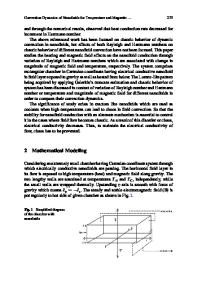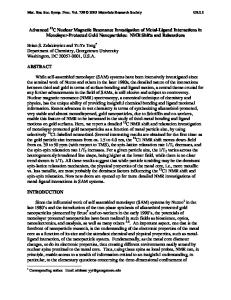In-situ nuclear magnetic resonance investigation of strain, temperature, and strain-rate variations of deformation-induc
- PDF / 260,703 Bytes
- 7 Pages / 612 x 792 pts (letter) Page_size
- 14 Downloads / 371 Views
I.
INTRODUCTION
IN an earlier article, we reported the results on enhanced diffusion during deformation of bulk single crystalline alkali halides (NaCl and NaF) and demonstrated the applicability of nuclear magnetic resonance (NMR) pulse techniques in evaluating the concentration of deformationinduced excess vacancies.[1] In addition, preliminary results obtained on thin foils of Al were briefly pointed out. Now, we report here the strain, strain-rate, and temperature variations of the excess vacancy concentration derived from NMR pulse experiments using the new CUT-sequence method. These results on the strain-induced vacancy concentration have important bearing on the understanding of the dynamic strain aging (DSA) and the development of quantitative models characterizing the DSA.[2,3] In particular, the critical strain (εc) for the onset of serrations is related to the strain-induced vacancy concentration and mobile dislocation density:[2,3] E b «z 5 A«m1 exp (2 m ), CV« } « mc , and rm } « bc c kT
[1]
Here, Cεv is the strain-induced vacancy concentration, rm is the density of mobile dislocations, and Em is the activation energy for vacancy migration. The constants m 1 b and Em are generally evaluated from the strain-rate and temperature dependencies of the critical strain on serrated flow in tensile tests. The present study enables an evaluation of the
K. LINGA MURTY is Professor, Department of Nuclear Engineering and Department of Materials Science & Engr., with North Carolina State University, Raleigh, NC 27695-7909. K. DETEMPLE, Graduate Research Assistant, and O. KANERT, Professor, are with the Department of Physics, University of Dortmund, 44221 Dortmund, Federal Republic of Germany. J.Th.M. DEHOSSON, Professor, is with the Department of Applied Physics, University of Groningen, 9747 AG Groningen, The Netherlands Manuscript submitted May 8, 1997 METALLURGICAL AND MATERIALS TRANSACTIONS A
strain-induced vacancy concentration rather directly. Moreover, the excess vacancies resulting in enhanced diffusion have strong influence on the creep behavior of metals and ceramics in that the activation energy for creep decreases with increased stress or strain rate if the concentration of these nonequilibrium vacancies is significant.[4–7] The dynamical behavior of point defects in metals is usually characterized by investigating annealing kinetics following extensive cold work. The recovery of induced plastic deformation is monitored using various techniques such as electrical resistivity,[8] positron lifetimes,[9] perturbed-angular correlation,[10] Mossbauer spectroscopy,[11] ultrasonic attenuation,[12] etc. In contrast to these two-step experiments, it is desirable to be able to investigate these kinetics in situ during deformation of materials in a single step. The plethora of nondestructive experimental techniques notwithstanding, very few of them are useful in the investigation of the dynamical properties of these defects. This is particularly true in the investigation of the diffusion of point defects and mo
Data Loading...









